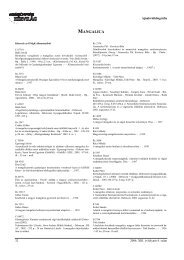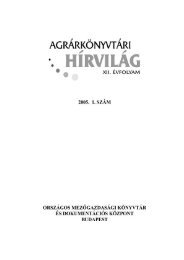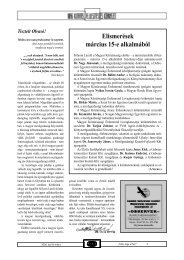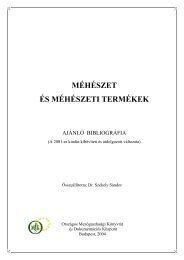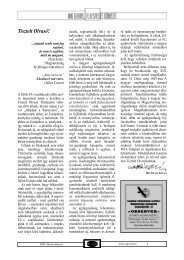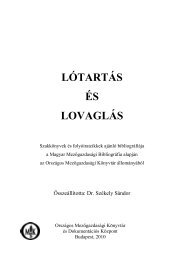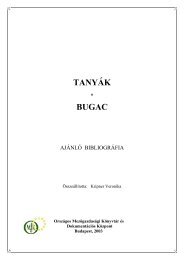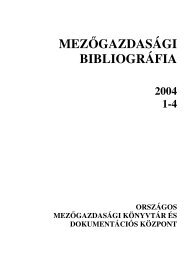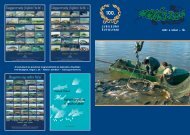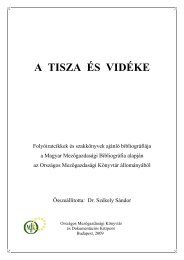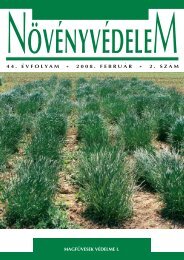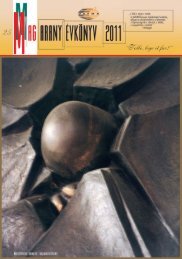hUNGARiAN AGRicUltURAl RESEARch
hUNGARiAN AGRicUltURAl RESEARch
hUNGARiAN AGRicUltURAl RESEARch
Create successful ePaper yourself
Turn your PDF publications into a flip-book with our unique Google optimized e-Paper software.
Table 1: Results of the Bass model fitting on monthly, quarterly and yearly time<br />
series<br />
(p: innovation parameter, q: imitation parameter, m: market potential, r 2 : square of the Pearson product<br />
moment correlation coefficients)<br />
series. Bass and ARIMA models<br />
were applied on the dataset with<br />
computer software: MS Office<br />
Excel 2003 and SPSS 11.0.1.<br />
Bass model was fitted on<br />
monthly, quarterly and yearly data<br />
to determine the model parameters<br />
and to forecast the potential market<br />
size by: a) OLS on the discrete<br />
form of the basic Bass model and<br />
b) NLLS on the Y(t) from the<br />
analogue Bass model.<br />
The results of OLE and NLLS<br />
regressions of the Bass model were<br />
summarised in Table 1.<br />
The original monthly data, the<br />
fitted Bass curve with one year<br />
ahead forecast by OLE were<br />
displayed in Figure 1.<br />
The comparison of the results of<br />
the OLE and NLS estimation<br />
methods were summarised in<br />
Table 2.<br />
Correlation analysis was carried<br />
out on the time interval (t), p, q, m,<br />
and R 2 at both regression methods.<br />
Results showed that the correlation<br />
is significant at the 0.01 level (2<br />
tailed) between p and q parameters,<br />
Table 2: Bass model – the<br />
comparison of the NLLS and<br />
OLE results<br />
and at the 0.05 level between m<br />
and t, p and t, q and t in the case of<br />
OLE regression and 0.01 level<br />
between q and t while there is 0.05<br />
significant level between R 2 and p<br />
at NLLS regression. OLE<br />
regression gives the next relation:<br />
q=27,848p–0,0216 with R 2 =1.<br />
ARIMA estimation. Monthly<br />
data were taken into consideration<br />
to have enough observations (more<br />
than 50) for the estimation in<br />
ARIMA modelling: The stationarity<br />
of the time series was tested<br />
by ACF and PACF and the<br />
required differencing transformation<br />
was made to remove trend<br />
component. The three step iteration<br />
process was played several times to<br />
determine the best ARIMA<br />
process. AIC and SBC values of<br />
the SPSS output were the base of<br />
the diagnostics – the lower were<br />
the values the better was the fit.<br />
The diagnostic process was<br />
completed with the examination of<br />
the residuals – if it was a white<br />
noise process.<br />
The iteration process resulted<br />
the SARIMA (2, 1, 2) (0, 12, 0)<br />
seasonal model, the model was<br />
described with the next equation:<br />
Goodness of fit: The square of<br />
the Pearson product moment<br />
correlation coefficient between the<br />
original and fitted data was<br />
0.85577 for the SARIMA model.<br />
One year ahead forecast of the<br />
sales volume for the alcoholic drink<br />
by SARIMA2,1,2)(0,12,0) are<br />
shown in Figure 2.<br />
Conclusions<br />
This work involved the<br />
deterministic Bass (1969) diffusion<br />
and the stochastic ARIMA time<br />
series models to model and forecast<br />
the spread of a food-stuff in<br />
Hungary based on representative<br />
monthly sales volumes from<br />
between 2004 and 2008. The<br />
investigated alcoholic drink was a<br />
new category entry. The plot of the<br />
monthly sales was ascendant with<br />
some seasonality. It seemed to be a<br />
successful product.<br />
The deterministic Bass model<br />
was fitted by OLE and NLLS on<br />
monthly quarterly and yearly data,<br />
the resulted parameters were<br />
examined. Significant correlation<br />
was found between the innovation<br />
and imitation parameters by OLE,<br />
Control: AIC=655.21, SBC=663.26, and the error was white noise.<br />
34 Hungarian Agricultural Research 2009/3–4



